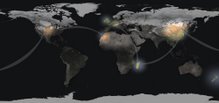Now why would I submit you to some arcane discussion of tools when I've tried so hard to stick to simple stories and keep that kind of stuff off of here? Simple. A few reasons. 1) the rumors are true, I'm a dork. 2) maybe you're wondering what I do all day. 3) as an editor, I haven't been spending much of my working life in the real world lately. Like, 12 months lately. Since manipulation of image and sound happen in a kind of imaginary electronic space, that's another layer of representation already applied to a layer of representation. Which (at some point beyond boredom) is a fascinating idea for a dork.
I learned nonlinear video editing in high school, and I've been using the same program for ten years. To me, learning to use Final Cut Pro at 18 was like understanding how to use a pen or a camera or to drive a car for the first time. Imagine looking at letters and pictures all your life but having no idea how they were made. All of a sudden, I could control the story.
Final Cut Pro did that for thousands of other people at around the same time. Video used to be possible only for big studios and TV stations and companies. Suddenly anyone with a camera, a cable and a mac full of hard drives could make their own little movies. Tell that to the millions of teenagers uploading videos to youtube this weekend and nobody cares - but a decade ago, it was unbelievable.
Then, a month ago, Apple kind of dumped FCP by making the newest version essentially useless for professionals. I'll admit, I was a little heartbroken at first. I'm plunged straight into learning a new set of tools under a deadline - and I'm surprised and happy to say that's a good thing. It's forcing me to break some old habits and concentrate again on making a story. Sometimes breakups are great.
Now I work with about five different programs at a time, all doing different parts of that job - arranging images and sound to tell a story. There's an endless amount of tweaking to be done with a different tool for each thing. The massive sensor inside the Red One camera generates an enormous amount of information. Four million points of light every 1/24th of a second - incident photons electrified and stored as raw computer data copied onto dual onboard hard drives. When I hook up those hard drives to a computer, open RedcineX and start working, this is what I see.
The fact that the data is raw from camera's sensor is significant. It starts out as flat and honest pixel information, ready for manipulation. You can do absolutely anything to it. With FCP, we would then render out these movies and then start editing them. That's very time consuming. And every time you change your mind about the look of a clip, you have to render it all over again. You get to continue sitting in your dark little box watching a bar crawl across the screen lying to you about how it's almost done. Lame. Tape has all but disappeared, but we've been living under the shadow of those filmish tape-like habits. Digital workflows can be the worst of both worlds. Remember how everyone used to talk about the paperless office and it never happened? And now you have just as many papers and TPS reports and piles of memos and things you could never make time to care about duplicated in two different electronic and physical landscapes? Like that.
For me, that is beginning to change. This is one example. The great thing about this new set of tools is that no matter how much I distort the image using all those settings, it never messes with the source file. I can give a clip as many different kinds of looks I want, and it just saves little matadata files. They're called .RMDs - like a handful of transparent celluloid sheets plopped over the original image, all interchangeable. And the best part is that in Adobe Premiere, I can cut a whole sequence, then go back to RedcineX, change anything, and it instantly reads the new .RMD and new colors ripple through into the movie with no waiting. What used to take a roomful of $10 millon machines and lights and 3 specialists and miles of film and hours of tweaking to achieve a single final irrevocable result now can be done in seconds by me alone at a cheap computer - and I can change my mind and redo it tomorrow.
Now, whether that fact alone will destroy all of the time-saving advancements in my digital film workflow... we'll see.
Subscribe to:
Post Comments (Atom)








No comments:
Post a Comment